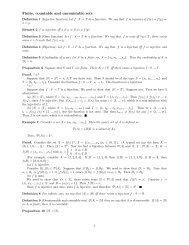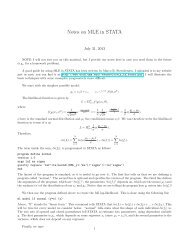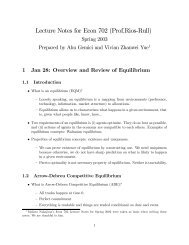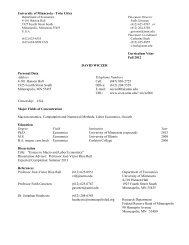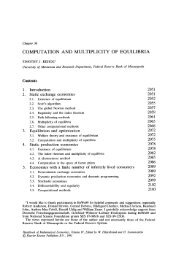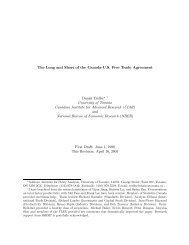Huggett model - University of Minnesota
Huggett model - University of Minnesota
Huggett model - University of Minnesota
Create successful ePaper yourself
Turn your PDF publications into a flip-book with our unique Google optimized e-Paper software.
Fatih Guvenen<br />
<strong>University</strong> <strong>of</strong> <strong>Minnesota</strong><br />
Homework #3<br />
Due back: Beginning <strong>of</strong> class, Tuesday, November 24, 2009.<br />
Questions indicated by a “star” are required for everybody who attends the class. You can use<br />
either MatLab or Fortran to do the homework.<br />
For each question, please discuss your answer. (Please do not merely provide some<br />
numbers and a code).<br />
1. This question will teach you about a different parameterization <strong>of</strong> CRRA utility functions<br />
that yields an approximately linear value function in a wide-range <strong>of</strong> economic problems.<br />
This approximate linearity will save you a substantial amount <strong>of</strong> time when you solve DP<br />
problems and need to interpolate the value function on the RHS. First, some preliminaries.<br />
This part asks you to do some algebra to get acquainted with Epstein-Zin preferences.<br />
(a) Consider a basic portfolio choice problem where preferences are given by the Epstein-Zin<br />
specification (also called “recursive preferences”). For the specifics <strong>of</strong> this problem, see<br />
Epstein (1988, JME). Derive the relative risk aversion coefficient with respect to wealth<br />
gambles, that is −W ((J ′′<br />
(W ))/(J ′<br />
(W ))) (where W is financial wealth and J(.) is the<br />
value function) and show that it is equal to (1/(1 − α)) where α is the exponent <strong>of</strong> the<br />
future utility.<br />
(b) Now, we will modify the problem a bit. Suppose that there is a single risk-free asset<br />
for investment subject to an ad hoc borrowing constraint (in the language <strong>of</strong> Aiyagari<br />
(1994)). Furthermore, suppose that the individual receives a stochastic labor income that<br />
follows a first order Markov process with a bounded support (again as in Aiyagari). Solve<br />
the dynamic programming problem <strong>of</strong> the individual numerically using value function<br />
iteration. Repeat the experiment for risk aversion coefficient <strong>of</strong> 2, and 10, and EIS<br />
values <strong>of</strong> 2, and 0.1. [Discussion: When you do value function iteration you will need<br />
to interpolate the value function next period (ie, on the right hand side <strong>of</strong> the Bellman<br />
equation) at the <strong>of</strong>f-grid points. You are free to use any kind <strong>of</strong> interpolation technique<br />
as you wish as long as you minimize the computational time necessary. If you feel like<br />
it, experiment with different choices (linear, spline, and Chebyshev) and report which<br />
one works best (in terms <strong>of</strong> delivering an accurate solution in as little time as possible).<br />
You should iterate until the discrepancy in the decision rule between successive iterations<br />
(under sup-norm) is less than 10 −8 . Finally, you should use a maximization routine that<br />
makes use <strong>of</strong> derivative information (such as Dbrent.f90 or some Newton-based algorithm<br />
for efficiency. In both cases, make sure to supply the correct analytical derivative <strong>of</strong> the<br />
right hand side <strong>of</strong> the Bellman equation, which is a bit more involved than with CRRA<br />
specification.<br />
1
(c) Plot the decision rules and value function as a function <strong>of</strong> individual’s financial wealth<br />
keeping his income shock constant at its average value.<br />
(d) Now set the parameters <strong>of</strong> the Epstein-Zin specification such that it reduces to standard<br />
CRRA utility. Solve the problem in part (b) again taking a risk aversion value <strong>of</strong> 2.<br />
Repeat with RRA= 10.<br />
(e) Now solve the portfolio choice problem in (d) again, BUT using the standard CRRA<br />
specification: U(c) = c1−α<br />
1−α You should get the exact same decision rule as in part (d),<br />
but the value function should have much more curvature. Plot the decision rules and<br />
value function to verify this claim. Compare the time necessary to solve each version <strong>of</strong><br />
the problem (you can use the built-in function “cpu_time” in Fortran 90 and the tic/toc<br />
commands in MatLab).<br />
2
(a) Epstein‐Zin preferences<br />
Econ 8312. Computational Methods<br />
Homework #3<br />
Iskander Karibzhanov<br />
Consider a basic portfolio choice problem where preferences are given by Epstein‐Zin specification. Letting w denote<br />
wealth at the beginning <strong>of</strong> period t, the budget constraint facing consumer in period t is<br />
���� �������� ���� where interest rate Rt is iid random variable. The value function solves the following functional equation<br />
����� � max ��<br />
���<br />
�<br />
���� �<br />
�<br />
����� �������� �<br />
�<br />
�� , � � 0<br />
such that the above budget constraint holds. Conjecture that value function and policy function take the form<br />
���� � ���� �<br />
� � ��� �<br />
where � and � are yet undetermined constants. Then we can rewrite budget constraint as<br />
� ��� � �1 ���� ���� �<br />
Taking first order condition with respect to consumption c, we obtain<br />
��� �<br />
��� ��<br />
� �� �<br />
�<br />
� �������� �� �� �������������� ��������� �� �<br />
� ��� ����������� �<br />
� �� �� ��� ��� ����� ����� �������� ����� ����1 ����������� �� �<br />
� �� �� �����1 ���������� ��� ����� �������� �<br />
����� ��� ������<br />
�� �� ��� ����<br />
� � ��1 ��������� �1 ������� �<br />
����� ��� ������<br />
���1���� Substituting this into expression for value function we get<br />
����� �<br />
� � ������ � ������ �������������� �<br />
� � ������ ����� ����1 ����������� �� �<br />
�<br />
� ������ �<br />
����� ��� ���������1<br />
������� � ������ � �1 ��������� Therefore, � and � are given by<br />
��� ���<br />
�<br />
�<br />
� ��� �<br />
�� ��<br />
�<br />
��1������ ��� ���<br />
�������<br />
Once we verified our guess, we can calculate the Arrow‐Pratt measure <strong>of</strong> the curvature <strong>of</strong> the value function<br />
�� �"���<br />
����� ����� ��� �1����� ������� �1��<br />
We thus have the following result: for Epstein‐Zin preferences, the value function is a power function <strong>of</strong> wealth, and its<br />
curvature is governed by attitude toward risk �.
(b) Hugget <strong>model</strong><br />
The economy consists <strong>of</strong> many infinitely lived households differing only with regard to their income shock yt and their<br />
asset holdings at. Households maximize their intertemporal utility <strong>of</strong> the Epstein‐Zin form. The value function is<br />
����,��� � max ����� ��� ������ ��������������<br />
� ����� ������,������� �<br />
�<br />
�<br />
��<br />
where yt is an income shock, logarithm <strong>of</strong> which I assume is a first‐order Markov chain with only three states<br />
log �� � ��0.1, 0, 0.1�<br />
and transition probability matrix Π given by<br />
1 0 0 1/3 1/3 1/3<br />
Π�.75�0<br />
1 0��.25�1/3<br />
1/3 1/3�<br />
0 0 1 1/3 1/3 1/3<br />
I assume that ��0.9, that the gross interest rate is ��1.01 and that the borrowing limit is equal to �� ��2.<br />
To solve this dynamic programming problem <strong>of</strong> the individual, I used smart value function iteration method exploiting<br />
monotonicity <strong>of</strong> policy function and quasi‐concavity <strong>of</strong> value function and cubic spline interpolation between grid‐points.<br />
In implementing this numerical algorithm I closely followed the steps described in Chapter 4 <strong>of</strong> Maussner DGE book.<br />
Initial guess <strong>of</strong> value function<br />
Assuming ���, I first solved for �� ���, � �� using the initial guess for the policy function ����, �� ���<br />
�� ���, �� � ��� ��������� ������� ��/� I used this �� ���, �� as initial guess for the general case when ���. I iteratively solved the following nonlinear system <strong>of</strong><br />
equations until convergence:<br />
�<br />
��� �� ���, �� � ����� � � ������ ����� ���, � ��� ��� �/�<br />
Using �����, ��, I solved for the initial guess <strong>of</strong> value function �� ��, �� at all other asset grid points using<br />
�� ��, �� � ���� � � � ��� � ��������, ����� �<br />
�� �/�<br />
Binary search<br />
To exploit the monotonicity <strong>of</strong> policy function I used the previous policy index as a starting point to find the maximum<br />
on the discrete grid. To exploit quasi‐concavity <strong>of</strong> value function, I used binary search algorithm which dramatically<br />
reduces the number <strong>of</strong> function evaluations. The idea uses the fact that a strictly quasi‐concave function defined over a<br />
grid <strong>of</strong> N points either takes its maximum at one <strong>of</strong> the two boundary points or in the interior <strong>of</strong> the grid. In the first case<br />
the function is decreasing (increasing) over the whole grid. In the second case the function is first increasing and then<br />
decreasing. As a consequence, we can pick the mid‐point <strong>of</strong> the grid and check if the maximum is to the le*ft <strong>of</strong> this<br />
midpoint (if the function is decreasing at this point) or to the right <strong>of</strong> this midpoint (if it is increasing). The binary search<br />
based on this principle needs at most log � � steps to reduce the grid to a set <strong>of</strong> three points that contains the<br />
maximum.<br />
Cubic spline interpolation<br />
In order to interpolate the value function next period at the <strong>of</strong>f‐grid points, I used cubic spline interpolation by setting<br />
first derivative <strong>of</strong> value function at end points to their analytical values found from envelope condition:<br />
� � ��, �� �����,�� ��� ��� � � � � � ��, ��� ���<br />
where ���, �� and � � ��, �� were calculated in previous iteration.<br />
The resulting tridiagonal system <strong>of</strong> linear equations was solved using LAPACK function pttrs which exploits the<br />
symmetric positive definite properties <strong>of</strong> the system.
Optimization solver (dbrent)<br />
I used binary search to constrain the maximum to lie between two adjacent points on the grid. Then I used cubic spline<br />
interpolation to approximate the r.h.s <strong>of</strong> the Bellman equation by a continuous function. What is left is to use an<br />
optimization method that is able to deal with both boundary and interior solutions <strong>of</strong> a one‐dimensional optimization<br />
problem. The derivative based Brent algorithm described in Numerical Recipes is an efficient alternative to derivative<br />
free methods like golden search. I only need to provide the correct analytical derivate <strong>of</strong> the r.h.s. <strong>of</strong> the Bellman<br />
equation.<br />
������� � ����������������� ,����� �<br />
�<br />
�������� � ����� � � � ������ �������� ,����� �<br />
� ���ΠV�a� ,y�����V� �a� ,y���<br />
where V��a� ,y�� was computed using analytical first derivative <strong>of</strong> the cubic spline that interpolates the value function.<br />
As a minor notice, as you can see I didn’t include the power 1/� in the formula for r.h.s <strong>of</strong> Bellman equation because it<br />
was unnecessary computational burden (raising to real power is rather expensive). Instead I negated the rhs if ��0. Termination criteria<br />
The value function iteration method was stopped if the largest absolute value <strong>of</strong> the difference in the value function<br />
between successive iterations were increasing from previous iteration.<br />
Mean Euler equation residual<br />
The Euler equation residuals were computed for 100,001 equally spaced points in the same interval ��2, 10� using the<br />
following formula<br />
�������<br />
���, �� �<br />
� ,����� �<br />
� ���ΠV�a� ,y��������� � �� � ������� ���<br />
��<br />
�� � � � �� �1<br />
where �� ,��� and ���� ,��� were computed using cubic interpolation <strong>of</strong> the optimal saving rule ����, �� and value<br />
function ���, �� at the residual grid points between the original asset grid points.<br />
The stationary distribution <strong>of</strong> Markov chain and uniform asset distribution was used as weighting matrix in averaging the<br />
Euler equation residuals.<br />
�
Results<br />
I compared the optimal saving decision rules from Epstein‐Zin and CRRA specification with very precise numerical<br />
solution obtained using policy function iteration with endogenous grid method. For mean Euler equation residuals I used<br />
a fine grid <strong>of</strong> 100,001 points in the interval [‐2,10].<br />
Epstein‐Zin<br />
CRRA<br />
CRRA<br />
VFI with exogenous grid<br />
VFI with exogenous grid PFI with endogenous grid<br />
� � �‐1 #it Mean EER Time Dendog #it Mean EER Time Dendog #it Mean EER Time<br />
‐1 ‐1 100000 26 8.64 · 10�� 74.28 2.27 · 10�� 27 8.61 · 10�� 56.65 2.19 · 10�� 25 1.54 · 10��� 1.80<br />
‐1 ‐1 50000 26 3.90 · 10�� 35.77 2.45 · 10�� 27 3.90 · 10�� 26.95 2.39 · 10�� 25 4.39 · 10��� 0.80<br />
‐1 ‐1 40000 26 7.05 · 10�� 28.04 2.58 · 10�� 27 7.05 · 10�� 20.91 2.52 · 10�� 25 1.58 · 10�� 0.59<br />
‐1 ‐1 30000 26 1.25 · 10�� 20.95 2.83 · 10�� 27 1.25 · 10�� 15.48 2.77 · 10�� 25 2.40 · 10�� 0.43<br />
‐1 ‐1 20000 26 2.63 · 10�� 13.83 3.76 · 10�� 27 2.63 · 10�� 10.18 3.74 · 10�� 25 8.65 · 10�� 0.29<br />
‐1 ‐1 10000 26 1.03 · 10�� 7.04 8.60 · 10�� 27 1.03 · 10�� 5.33 8.56 · 10�� 25 3.09 · 10�� 0.14<br />
‐1 ‐1 1000 30 4.73 · 10�� 0.77 3.24 · 10�� 28 4.73 · 10�� 0.51 3.25 · 10�� 26 3.94 · 10�� 0.02<br />
‐1 ‐1 100 131 2.87 · 10�� 0.32 7.59 · 10�� 44 3.14 · 10�� 0.08 7.91 · 10�� 46 2.59 · 10�� 0.00<br />
‐1 ‐1 20 234 1.32 · 10�� 0.11 1.60 · 10�� 698 1.49 · 10�� 0.23 1.78 · 10�� 79 1.59 · 10�� 0.00<br />
‐9 ‐9 50000 261 1.58 · 10�� 318.91 1.05 · 10�� 279 1.56 · 10�� 257.78 9.32 · 10�� 173 5.66 · 10��� 5.86<br />
‐9 ‐9 40000 290 1.37 · 10�� 285.85 1.38 · 10�� 291 1.35 · 10�� 218.28 1.25 · 10�� 167 9.85 · 10��� 4.47<br />
‐9 ‐9 30000 257 4.40 · 10�� 192.34 1.80 · 10�� 279 4.38 · 10�� 157.24 1.66 · 10�� 197 1.55 · 10�� 3.59<br />
‐9 ‐9 20000 295 1.11 · 10�� 155.20 2.17 · 10�� 278 1.10 · 10�� 107.17 2.05 · 10�� 195 2.72 · 10�� 2.39<br />
‐9 ‐9 10000 293 3.08 · 10�� 74.29 4.27 · 10�� 284 3.08 · 10�� 52.27 4.22 · 10�� 182 8.58 · 10�� 1.11<br />
‐9 ‐9 1000 286 1.77 · 10�� 7.37 1.25 · 10�� 282 1.76 · 10�� 5.12 1.24 · 10�� 185 1.85 · 10�� 0.11<br />
‐9 ‐9 100 245 4.89 · 10�� 0.53 1.42 · 10�� 281 5.60 · 10�� 0.50 1.65 · 10�� 172 6.19 · 10�� 0.01<br />
‐9 ‐9 20 164 3.21 · 10�� 0.10 3.91 · 10�� 299 3.85 · 10�� 0.14 6.55 · 10�� 201 4.07 · 10�� 0.00<br />
As we can see, the CRRA method with high risk aversion (RRA=10) requires 10 times longer run time to obtain the same<br />
accuracy as the same CRRA method with low RRA=2. The EZ method is more time consuming than CRRA method and<br />
also 10 times more consuming if we increase risk aversion from 2 to 10.<br />
The optimal decision rules are almost exactly the same as can be seen from the following figure.<br />
assets tomorrow<br />
1.5<br />
1<br />
0.5<br />
0<br />
-0.5<br />
-1<br />
-1.5<br />
Discrepancy between optimal saving decision rules in EZ and CRRA methods<br />
x 10-7<br />
2<br />
-2<br />
-2 0 2 4<br />
assets today<br />
6 8 10<br />
The following graphs illustrate the decision rules and value function as a function <strong>of</strong> individual’s financial wealth.
assets tomorrow<br />
assets tomorrow<br />
10<br />
8<br />
6<br />
4<br />
2<br />
0<br />
y low<br />
y medium<br />
y high<br />
Optimal saving decison rule, RRA=2<br />
-2<br />
-2 0 2 4<br />
assets today<br />
6 8 10<br />
10<br />
8<br />
6<br />
4<br />
2<br />
0<br />
y low<br />
y medium<br />
y high<br />
Optimal saving decison rule, RRA=10<br />
-2<br />
-2 0 2 4<br />
assets today<br />
6 8 10
assets tomorrow<br />
assets tomorrow<br />
-1.75<br />
-1.8<br />
-1.85<br />
-1.9<br />
-1.95<br />
y low<br />
y medium<br />
y high<br />
Optimal saving decison rule, RRA=2<br />
-2<br />
-2 -1.95 -1.9 -1.85<br />
assets today<br />
-1.8 -1.75<br />
-1.75<br />
-1.8<br />
-1.85<br />
-1.9<br />
-1.95<br />
y low<br />
y medium<br />
y high<br />
Optimal saving decison rule, RRA=10<br />
-2<br />
-2 -1.95 -1.9 -1.85<br />
assets today<br />
-1.8 -1.75
0.17<br />
0.16<br />
0.15<br />
0.14<br />
0.13<br />
0.12<br />
0.11<br />
0.1<br />
Value function, EZ method, RRA=2<br />
0.09<br />
-2 0 2 4 6 8 10<br />
-6<br />
-6.5<br />
-7<br />
-7.5<br />
-8<br />
-8.5<br />
-9<br />
-9.5<br />
-10<br />
-10.5<br />
Value function, CRRA method, RRA=2<br />
-11<br />
-2 0 2 4 6 8 10
1.1<br />
1.05<br />
1<br />
0.95<br />
0.9<br />
0.85<br />
0.8<br />
0.75<br />
0.7<br />
-2 0 2 4 6 8 10<br />
0<br />
-0.5<br />
-1<br />
-1.5<br />
-2<br />
Value function, EZ method, RRA=10<br />
Value function, CRRA method, RRA=10<br />
-2.5<br />
-2 0 2 4 6 8 10<br />
As we expected, the value function in CRRA specification has more curvature than in EZ specification.



